A Little Local Colour
Havana, Cuba
by Sarah Shuckburgh
A few days in Havana and Sarah
Shuckburgh loses her British reserve as she dances in the
street and relives her teenage love affair with a handsome
revolutionary. Cuba does that to you.
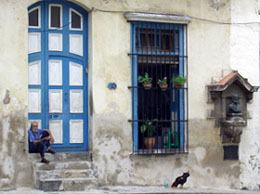 I sit on a bench in a tiny park, and the colour, music
and exuberance of old Havana engulf me. The air is
smothering - a hot, wet blanket, heavy with humidity - but
heat cannot dim the joie de vivre of the Habaneros. An
intoxicating blend of Spanish guitars and African drumbeats
drifts from a nearby bar, where an elderly couple is
performing an afternoon salsa. Workmen repairing a stone
fountain add strange syncopated rhythms with their chisels.
In the shade of a tree, an old man chats to his caged birds,
a smouldering cigar dangling from his lips. Three barefoot
boys in tattered shorts ki I sit on a bench in a tiny park, and the colour, music
and exuberance of old Havana engulf me. The air is
smothering - a hot, wet blanket, heavy with humidity - but
heat cannot dim the joie de vivre of the Habaneros. An
intoxicating blend of Spanish guitars and African drumbeats
drifts from a nearby bar, where an elderly couple is
performing an afternoon salsa. Workmen repairing a stone
fountain add strange syncopated rhythms with their chisels.
In the shade of a tree, an old man chats to his caged birds,
a smouldering cigar dangling from his lips. Three barefoot
boys in tattered shorts ki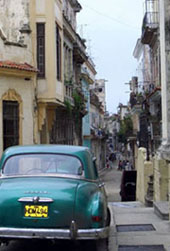 ck a dented can over the cobbles,
splashing through puddles from last night’s rain. A scrawny
street-sweeper hobbles by, licking her ice cream. Another
old crone squats in front of a sky-blue door, selling single
cigarettes. Bare-chested men exchange jokes as they push
barrows of rubble. A grizzled, toothless man approaches me
and holds out his hand. I give him a few tiny coins. ck a dented can over the cobbles,
splashing through puddles from last night’s rain. A scrawny
street-sweeper hobbles by, licking her ice cream. Another
old crone squats in front of a sky-blue door, selling single
cigarettes. Bare-chested men exchange jokes as they push
barrows of rubble. A grizzled, toothless man approaches me
and holds out his hand. I give him a few tiny coins.
 As I look up, a woman leans from an ornate, rusty balcony to
hang out washing, and waves down at me. Beneath her, the
peeling stucco façade of the once-grand house is
criss-crossed with wooden scaffolding. The old town contains
incredible architecture, with colonial buildings from the
16th century onwards - many crumbling and decrepit, but
others newly rescued and restored, partly as a result of
UNESCO World Heritage funds. Open portals lead to vibrant
art galleries and cool, leafy courtyards. As I look up, a woman leans from an ornate, rusty balcony to
hang out washing, and waves down at me. Beneath her, the
peeling stucco façade of the once-grand house is
criss-crossed with wooden scaffolding. The old town contains
incredible architecture, with colonial buildings from the
16th century onwards - many crumbling and decrepit, but
others newly rescued and restored, partly as a result of
UNESCO World Heritage funds. Open portals lead to vibrant
art galleries and cool, leafy courtyards.
On a corner, the house where Simón Bolívar once lived now
contains exhibits illustrating his life - amusing ceramic
vignettes depict him being born, being breast-fed, and later
having sex in a hammock, as well as liberating Latin America
from colonial hegemony.
Bolívar died aged 47, disillusioned at his failure to form a
unified Latin American republic - but today ‘El Libertador’
is revered as a saint. Passing his statue, I cross the
street to a small café where, over a delicious guava
milkshake, I ponder our own lack of equivalent heroes.
Britons have nobody like Bolívar to look up to. Cubans are
lucky, with several giants to worship - not light-weight
media celebrities, but principled, visionary reformers.
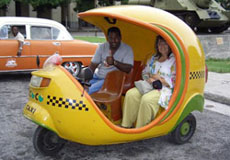 Fidel
Castro is one of them. There are few photographs of him, and
no statues, but for most Cubans, Castro is a living legend
who has maintained his communist ideals despite the collapse
of communism elsewhere, and despite crippling sanctions and
embargoes from the ‘Enemy’ to the north. The Cubans I speak
to all share Il Presidente’s patriotism and his distrust of
democracy, and are intensely proud of Cuba’s egalitarianism,
education and health care, and world-class sporting
achievements. Nobody mentions civil liberties, human rights
or freedom of expression. Fidel
Castro is one of them. There are few photographs of him, and
no statues, but for most Cubans, Castro is a living legend
who has maintained his communist ideals despite the collapse
of communism elsewhere, and despite crippling sanctions and
embargoes from the ‘Enemy’ to the north. The Cubans I speak
to all share Il Presidente’s patriotism and his distrust of
democracy, and are intensely proud of Cuba’s egalitarianism,
education and health care, and world-class sporting
achievements. Nobody mentions civil liberties, human rights
or freedom of expression.
 I wander on through a series of beautiful 16th-century
squares, cordoned from traffic with huge cannonballs. In the
exquisite Plaza Vieja, a group of tiny children appear with
two teachers, and start their PE lesson - the boys in a
circle, doing press-ups and star-jumps, the girls running in
and out of the bollards. At a flower stall, a yellow
motor-scooter coco-taxi judders to a halt, and an elderly
passenger clambers from under the coconut-shaped canopy, to
buy gladioli and fragrant white mariposa - ‘butterfly’
flowers. I wander on through a series of beautiful 16th-century
squares, cordoned from traffic with huge cannonballs. In the
exquisite Plaza Vieja, a group of tiny children appear with
two teachers, and start their PE lesson - the boys in a
circle, doing press-ups and star-jumps, the girls running in
and out of the bollards. At a flower stall, a yellow
motor-scooter coco-taxi judders to a halt, and an elderly
passenger clambers from under the coconut-shaped canopy, to
buy gladioli and fragrant white mariposa - ‘butterfly’
flowers.
Habaneros play music, laugh and dance at every opportunity,
but times are hard. Beyond Plaza Vieja, the streets are
pot-holed and strewn with rubbish, and families sit on
doorsteps in front of squalid, sparsely-furnished rooms. The
average wage is £7 a month - food is scarce, and housing is
in crisis. The Cubans I speak to hope that tourism and
foreign investment will help to alleviate poverty, but admit
that the tourist peso, worth twenty times the local peso, is
itself creating class divisions between those with access to
it, and those without.
But despite il lurchar, Cubans remain cheerfully
egalitarian, and as enthralled as ever by their most famous
hero. I remember my own Che Guevara poster, pinned to my
bedroom wall 35 years ago. Sixth-form pupils, at the school
where I teach, have an identical poster in their common room
today - but nothing prepares me for Il Commandante’s iconic
importance in Cuba.
 Che was an Argentinian doctor, who spent only 6 years here,
but his face and his slogans appear on hundreds of Havana
billboards. His huge illuminated portrait covers the side of
a building in Revolution Square, and his photograph hangs in
every classroom, where children pledge each day to emulate
him - “Seremos como El Che”. Che was an Argentinian doctor, who spent only 6 years here,
but his face and his slogans appear on hundreds of Havana
billboards. His huge illuminated portrait covers the side of
a building in Revolution Square, and his photograph hangs in
every classroom, where children pledge each day to emulate
him - “Seremos como El Che”.
I stop for a mojito in a café where ten exuberant musicians
are performing on guitar, 6-stringed tres, double bass,
flute, bongos, maracas, and clavé s - two sticks banged
together. The musicians are all men - machismo rules here -
but their skins are of every shade from black to white, and
they are all smiling.
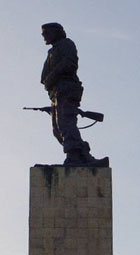 Their music is fantastic - long sets
with false endings, rap sections, solo instrumental
interludes - and the sense of fun is infectious. Their music is fantastic - long sets
with false endings, rap sections, solo instrumental
interludes - and the sense of fun is infectious.
To my amazement, I suddenly lose my uptight British reserve,
and leap to my feet, dancing and shaking the maracas which
are thrust into my hands. Che Guevara’s portrait looks down
from the wall, and the musicians start playing a favourite
tune - ‘Here remains the clear transparency of your dear
presence, Commandante Che Guevara‘.
Havana’s Museum of the Revolution includes a life-size
diorama of Che Guevara in battle, and displays his
Kalashnikov and his famous beret. Images of Che, alive and
dead, are accompanied by precious relics - a lock of hair,
wisps of his beard, and remnants of the socks and jersey he
was wearing when he was killed. The links with religious
iconography are startling. He appears as a Christ-like
figure, charismatic and courageous, challenging injustice,
and sacrificing his life to save the oppressed. Che’s
asceticism, his idealism, his disapproval of greed, his hard
work and altruism, remind me of the Puritan work ethic, but
with individual faith in God replaced by collectivism.
Outside, like a shrine, stands a replica of the boat which
brought Che, Castro and 81 other rebels to Cuba in 1956.
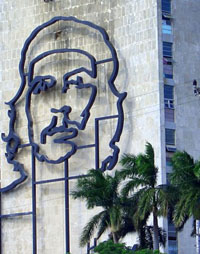 Later, I visit Che’s impressive, but deserted, mausoleum in
Santa Clara. Beneath a vast bronze statue is a gallery of
photographs and memorabilia, including his white doctor‘s
coat, and another beret. As I peer at his school reports, I
inadvertently touch a glass cabinet, and guards swoop.
Backing to a respectful distance, I marvel at how photogenic
Che was - his romantic features utterly mesmerising, from
classroom to battlefield. During his brief spell as a
short-haired government minister, he looked like a portly
Lord Lucan, but luckily, by his death, the Heroic Guerillero
had lost weight, and grown his hair and beard, and looked
beautiful once more. In the crypt, Che’s body, retrieved
from Bolivia in 1997, is interred with the remains of other
rebels. Fresh flowers adorn every grave, and an eternal
flame, lit by Castro, burns in an eerie grotto. Later, I visit Che’s impressive, but deserted, mausoleum in
Santa Clara. Beneath a vast bronze statue is a gallery of
photographs and memorabilia, including his white doctor‘s
coat, and another beret. As I peer at his school reports, I
inadvertently touch a glass cabinet, and guards swoop.
Backing to a respectful distance, I marvel at how photogenic
Che was - his romantic features utterly mesmerising, from
classroom to battlefield. During his brief spell as a
short-haired government minister, he looked like a portly
Lord Lucan, but luckily, by his death, the Heroic Guerillero
had lost weight, and grown his hair and beard, and looked
beautiful once more. In the crypt, Che’s body, retrieved
from Bolivia in 1997, is interred with the remains of other
rebels. Fresh flowers adorn every grave, and an eternal
flame, lit by Castro, burns in an eerie grotto.
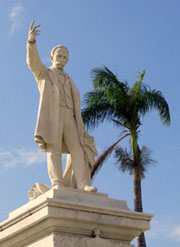 Che is a folk hero, but every Cuban I speak to mentions
another, even greater national totem, a man whose name I
barely knew. José Martí ’s memorial, the tallest building in
Cuba, dominates Havana’s Revolution Square. His statue, with
moustache and thick swirling hair, appears in every Cuban
town. Throughout the country, main streets and boulevards
are named after him. Like Bolívar, he was a visionary,
passionately determined to free Latin America from foreign
colonialism. Like Che, he fought for Cuban independence, but
spent little of his life in Cuba. Born into poverty in 1853,
he became the father of Cuban nationalism, a literary giant
who wrote plays, poems and essays, a rebel who hated
violence - a saintly man of peace and principle. Che is a folk hero, but every Cuban I speak to mentions
another, even greater national totem, a man whose name I
barely knew. José Martí ’s memorial, the tallest building in
Cuba, dominates Havana’s Revolution Square. His statue, with
moustache and thick swirling hair, appears in every Cuban
town. Throughout the country, main streets and boulevards
are named after him. Like Bolívar, he was a visionary,
passionately determined to free Latin America from foreign
colonialism. Like Che, he fought for Cuban independence, but
spent little of his life in Cuba. Born into poverty in 1853,
he became the father of Cuban nationalism, a literary giant
who wrote plays, poems and essays, a rebel who hated
violence - a saintly man of peace and principle.
José Martí , everyone I speak to agrees, is Cuba’s true
hero. He was born in Havana, but was exiled at the age of 16
after writing revolutionary tracts, and returned to Cuba for
only a few months before his death in 1895. He devoted his
life, by peaceful means, to the cause of Cuban independence,
writing essays and articles in New York, Mexico and Spain.
Suddenly, I notice his face and his name everywhere.
 That evening, beneath a bust of Martí , I sip a pina colada,
and tap my foot to another exuberant son ensemble.
Yesterday’s grizzled beggar reappears, and laughing
toothlessly, thanks me again, raising his hands in high
fives. The musicians start to play Guajira Guantanamera -
the girl from Guantanamo - Cuba’s most famous song, which
includes lines by Martí . That evening, beneath a bust of Martí , I sip a pina colada,
and tap my foot to another exuberant son ensemble.
Yesterday’s grizzled beggar reappears, and laughing
toothlessly, thanks me again, raising his hands in high
fives. The musicians start to play Guajira Guantanamera -
the girl from Guantanamo - Cuba’s most famous song, which
includes lines by Martí .
I leave Havana after dark. A hot wind is blowing, and the
dimly lit town seems impossibly exotic and romantic. The
silhouette of the 16th-century Castilla de San Salvador de
la Punta looms mysteriously. Waves splash against the Malecó
n seawall, where couples sit kissing and cuddling. Decrepit
Dodges and Cadillacs lurch up La Rampa, past coco-taxis,
motorbikes with sidecars, and wobbly rickshaws. From the
inky expanses of Revolution Square, the vast outline of Che
Guevara’s handsome face watches over the floodlit marble
statue of José Martí .
First published by the Telegraph
©SarahShuckburgh |